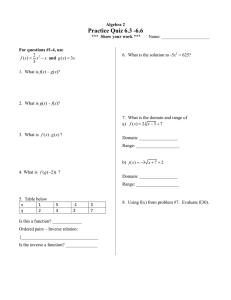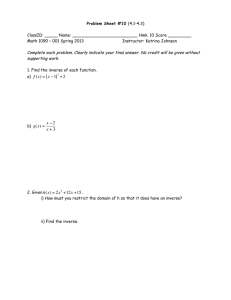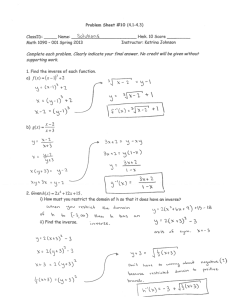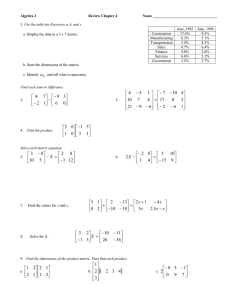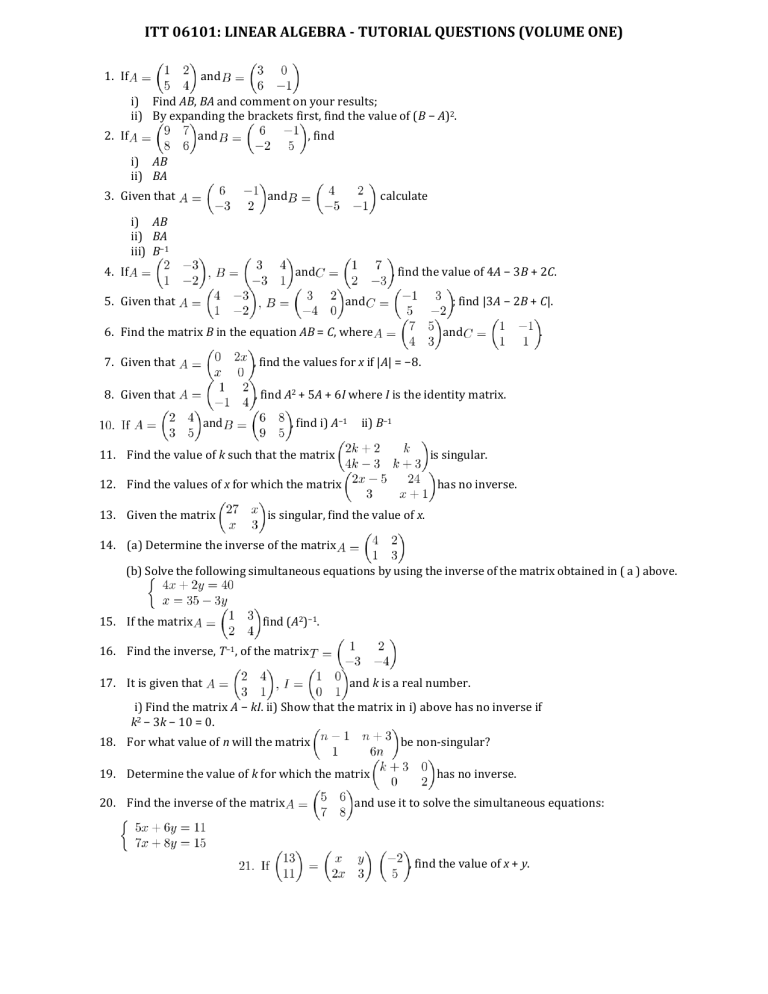
ITT 06101: LINEAR ALGEBRA - TUTORIAL QUESTIONS (VOLUME ONE) 1. If and i) Find AB, BA and comment on your results; ii) By expanding the brackets first, find the value of (B − A)2. 2. If and , find i) AB ii) BA 3. Given that and calculate i) AB ii) BA iii) B−1 4. If and 5. Given that , find the value of 4A − 3B + 2C. and ; find |3A − 2B + C|. 6. Find the matrix B in the equation AB = C, where and 7. Given that , find the values for x if |A| = −8. 8. Given that , find A2 + 5A + 6I where I is the identity matrix. and , find i) A−1 ii) B−1 11. Find the value of k such that the matrix is singular. 12. Find the values of x for which the matrix 13. Given the matrix . has no inverse. is singular, find the value of x. 14. (a) Determine the inverse of the matrix (b) Solve the following simultaneous equations by using the inverse of the matrix obtained in ( a ) above. 15. If the matrix find (A2)−1. 16. Find the inverse, T−1, of the matrix 17. It is given that and k is a real number. i) Find the matrix A − kI. ii) Show that the matrix in i) above has no inverse if k2 − 3k − 10 = 0. 18. For what value of n will the matrix be non-singular? 19. Determine the value of k for which the matrix 20. Find the inverse of the matrix has no inverse. and use it to solve the simultaneous equations: , find the value of x + y. 22. Solve the following simultaneous equations by matrix method. 23. Solve the simultaneous equations below using the matrix method: 24. Use the matrix method to solve the following simultaneous equations: 25. Find x and y given that 26. (a) Write the pair of simultaneous equations below as a matrix equation: (b) Solve for x and y in (a) above by inverse matrix. 27. Solve for x and . 28. Solve the equation 2 29. Solve, by matrix method, the pair of simultaneous equations: 30. Use inverse matrix method to solve the following system of equations: = 12 31. Use matrix method to solve for x and y for the following system: 1. 2. 3. Linear Transformations A linear transformation T maps u = (3,−4) into (−5,3) and v = (3,1) into (5,18). Find i) the matrix T ii) T [3u − 2v] Suppose T is a linear transformation such that: T [U] = (1,−2); T [V ] = (−3,−1); for any vectors U and V . Find i) T [U + V ] ii) T [8U] iii) T [3U − 2V ] If vectors u = i − 8j and v = 5i + 2j and a linear transformation T has a property that T [u] = and 4. The matrix i) ii) 5. ; find T [3(u + 2v)]. represents a single transformation. Describe fully this transformation Find the coordinates of the image of the point (5,3) after this transformation. A transformation T has the matrix, . Under the same transformation T, the point (−4,1) is mapped onto the point (6,3). Find x and r. 6. A linear transformation T has matrix . Find i) the image of point (2,3) under T. ii) coordinates of the point having an image of (7,2) under T by using the matrix method. 7. Find the image of the vector 8. A quadrilateral has its vertices at O(0,0), A(0,2), B(2,2) and C(2,0). Given the transformation T defined by under the transformation given by the matrix . Find the coordinates of the figure O0A0B0C0 obtained by transforming the quadrilateral OABC, hence draw OABC and its image on the same axes. 9. The transformation maps the triangle A(3,2), B(7,2) and C(3,8) onto the triangle A0B0C0. Find the coordinates of A0, B0 and C0. 10. Given , find the image of (2,3) under this mapping. 11. A linear transformation M maps the point (x,y) onto (x0,y0) where x0 = x − y y0 = 2x + y i) Write the matrix M of this transformation. ii) What is the matrix M−1 or the inverse of M? iii) Compute the product matrix MM−1. 12. A linear transformation T maps (x,y) onto (x0,y0) such that . Find the image of (2,−3) under T. 13. A linear transformation T maps the point (x,y) onto (x0,y0) where (x0,y0) = (x + y,−x + 2y). Determine the matrix T of this transformation. Find the determinant and inverse of T. 14. A linear transformation T maps (x,y) onto (x0,y0) where x0 = x − y and y0 = x + 2y. i) Write down the matrix of T ii) Find the image of (5,3) under T iii) Find the point (x,y) whose image under T is (−5,16).
